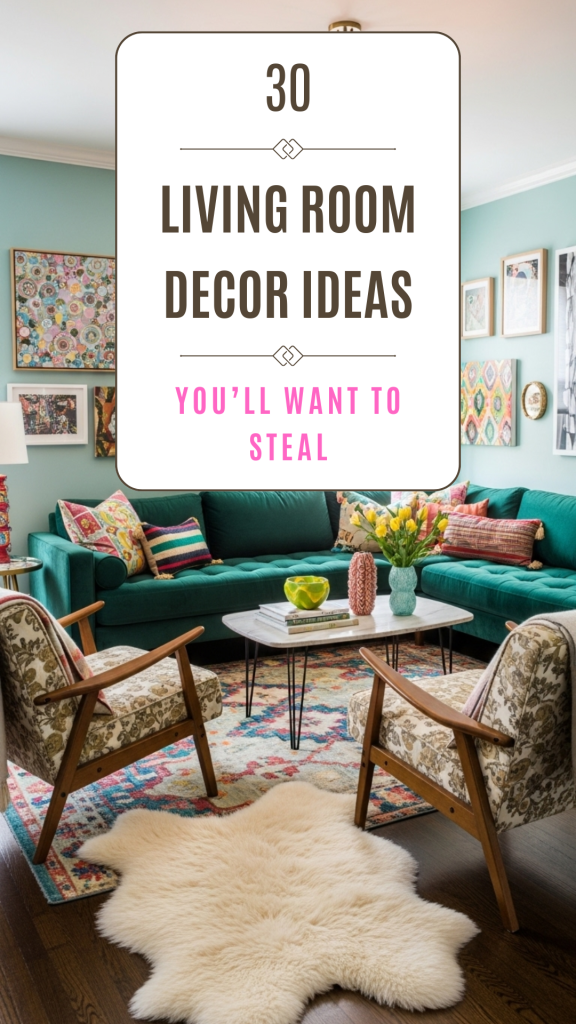A beautiful living room isn’t just about style—it’s about making your space functional, welcoming, and reflective of your personal taste.
Whether you’re redesigning from scratch or just want to refresh a tired look, these 30 stunning living room decor ideas will help you rethink every corner. Each idea comes with reasons why it works and practical do’s and don’ts to help you get it just right.

Table of Contents

1. Layer Textures for Depth and Warmth
Why it works: Mixing textures—like velvet cushions, chunky knits, woven rugs, and smooth leather—creates visual interest and coziness.
How to do it:
- Combine at least 3 different textures in your decor (pillows, throws, rugs).
- Stick to a unified color palette to keep it cohesive.
What not to do: - Avoid overloading with too many rough or heavy textures that can feel overwhelming.
2. Add a Statement Art Piece
Why it works: A large piece of art becomes an instant focal point and adds personality.
How to do it:
- Choose a bold abstract or oversized photograph that ties into your room’s color scheme.
- Hang it at eye level above a sofa or mantle.
What not to do: - Don’t clutter the wall with too many smaller frames that distract from your centerpiece.
3. Float Your Furniture
Why it works: Pulling furniture away from walls makes the room feel more spacious and intentional.
How to do it:
- Use a rug to anchor the layout.
- Leave at least 3–4 inches between furniture and walls.
What not to do: - Avoid pushing everything against the perimeter; it can make the room feel cold and disconnected.
4. Go Monochrome with a Twist
Why it works: A single-color palette looks clean and sophisticated, while accents add depth.
How to do it:
- Pick one main hue and vary the tones (light to dark).
- Use metallics or natural wood for contrast.
What not to do: - Don’t let the room fall flat—add a mix of materials to keep it dynamic.
5. Try Gallery Walls with a Theme
Why it works: Gallery walls tell a story and show off your personality.
How to do it:
- Stick to a theme (e.g. travel, black and white photography).
- Use consistent frames for a polished look.
What not to do: - Avoid mixing frame styles and sizes randomly—it can look chaotic.
6. Use Oversized Floor Lamps
Why it works: They add drama and sculptural form while providing functional lighting.
How to do it:
- Choose an arc or tripod lamp that complements your furniture.
- Place near seating areas for reading light.
What not to do: - Don’t use it as the only light source—layer with ceiling and table lights.
7. Embrace Earthy, Neutral Tones
Why it works: Warm neutrals like terracotta, beige, and sand create a grounded and calming vibe.
How to do it:
- Combine multiple earthy shades to add richness.
- Add plants and natural materials like jute or linen.
What not to do: - Avoid making the room feel flat—play with texture and tone for variety.
8. Add a Touch of Black
Why it works: Black anchors a space and adds instant sophistication.
How to do it:
- Use black in light fixtures, picture frames, or coffee tables.
- Contrast it with lighter surroundings.
What not to do: - Don’t overuse it in small spaces—it can feel heavy and cramped.
9. Incorporate Built-In Shelving
Why it works: It maximizes space while providing a beautiful display for books and decor.
How to do it:
- Style shelves with a mix of books, vases, and framed photos.
- Leave breathing space between objects.
What not to do: - Don’t fill every inch—negative space is key for a curated look.
10. Go Bold with a Colorful Sofa
Why it works: A colorful sofa becomes the statement piece of your living room.
How to do it:
- Choose jewel tones like emerald or sapphire for elegance.
- Keep the rest of the decor muted.
What not to do: - Don’t mix too many bold colors—let the sofa shine.
11. Mix Old and New Pieces
Why it works: Blending vintage and modern creates a layered, lived-in look.
How to do it:
- Pair antique furniture with sleek lighting or art.
- Use contrasting materials (metal with wood, modern with rustic).
What not to do: - Don’t let one style dominate too much—it should feel balanced.
12. Create a Cozy Corner
Why it works: A designated reading or coffee spot adds comfort and function.
How to do it:
- Add a comfy armchair, a small side table, and a lamp.
- Include a throw blanket and small plant.
What not to do: - Avoid overcrowding—keep the nook simple and serene.
13. Make Use of Mirrors
Why it works: Mirrors bounce light and make your space feel bigger and brighter.
How to do it:
- Hang a large mirror opposite a window.
- Use mirrored furniture for extra glam.
What not to do: - Don’t place mirrors in cluttered areas—they’ll reflect the mess.
14. Install Picture Frame Molding
Why it works: It adds architectural interest and elegance to plain walls.
How to do it:
- Paint the molding and wall the same color for subtle texture.
- Keep spacing even and symmetrical.
What not to do: - Don’t overdo it in small rooms—it can overwhelm the space.
15. Bring in Large-Scale Plants
Why it works: Plants bring life, movement, and freshness to the room.
How to do it:
- Use plants like fiddle leaf figs or monstera.
- Choose stylish pots that match your decor.
What not to do: - Don’t neglect plant care—dying plants ruin the aesthetic.
16. Choose a Rug That Defines the Space
Why it works: A rug anchors your seating area and ties the room together visually.
How to do it:
- Use a rug large enough that at least the front legs of your furniture sit on it.
- Choose patterns or colors that complement your decor.
What not to do: - Avoid rugs that are too small—they make the room look disjointed and awkward.
17. Add Pops of Color Through Accessories
Why it works: Accent colors inject energy without overwhelming the space.
How to do it:
- Use throw pillows, vases, or art in 1–2 accent colors.
- Repeat the colors in at least three places for cohesion.
What not to do: - Don’t use too many bold tones in small doses—they can clash and feel scattered.
18. Install Sconces for Ambient Lighting
Why it works: Wall sconces free up surface space while creating a warm, layered glow.
How to do it:
- Position on either side of artwork, mirrors, or sofas.
- Use dimmable options for mood control.
What not to do: - Don’t install them too high—eye level or just above works best.
19. Use Console Tables Behind Sofas
Why it works: A console adds surface space and dimension, especially in open layouts.
How to do it:
- Style with a pair of lamps, a stack of books, or seasonal decor.
- Choose a table slightly lower than the back of the sofa.
What not to do: - Don’t overcrowd the console—leave space for visual breathing room.
20. Frame Your Windows with Floor-Length Curtains
Why it works: Tall curtains draw the eye upward and make ceilings appear higher.
How to do it:
- Hang curtain rods close to the ceiling and extend wider than the window frame.
- Choose light, airy fabrics for a soft finish.
What not to do: - Don’t stop the curtains at the window base—it visually shortens the space.
21. Add a Stylish Coffee Table Setup
Why it works: A well-styled coffee table acts as a central decor hub.
How to do it:
- Group items in odd numbers (books, candles, a tray).
- Vary height and texture for visual interest.
What not to do: - Don’t overcrowd—leave space for practical use like setting down drinks.
22. Incorporate Arches and Curves
Why it works: Curved furniture and arches soften the lines of your room and feel contemporary yet classic.
How to do it:
- Use rounded mirrors, arched shelving, or curved sofas.
- Balance curves with clean-lined elements for contrast.
What not to do: - Don’t mix too many different curve styles—they can clash instead of flow.
23. Add an Accent Wall with Paint or Wallpaper
Why it works: It creates a focal point and adds character without overwhelming the room.
How to do it:
- Choose a bold paint color or patterned wallpaper for one wall.
- Balance with neutrals on the remaining walls.
What not to do: - Avoid clashing colors—stick to complementary tones for cohesion.
24. Include a Mix of Seating Options
Why it works: A combination of sofas, chairs, and poufs offers variety and flexibility for entertaining.
How to do it:
- Create conversation-friendly layouts with different seat heights and styles.
- Use matching colors or textures for unity.
What not to do: - Don’t block walkways—keep enough space to move comfortably.
25. Use Transparent Furniture in Small Spaces
Why it works: Lucite or glass tables keep things light and visually open in tighter rooms.
How to do it:
- Try a clear coffee or side table.
- Pair with bold accessories to add contrast.
What not to do: - Don’t rely solely on transparent pieces—they need grounding elements for balance.
26. Keep the Ceiling in Mind
Why it works: Treating the ceiling as a design element adds unexpected drama.
How to do it:
- Paint it a soft color, install beams, or use wallpaper.
- Use it to complement the overall palette.
What not to do: - Don’t go too dark unless your room gets a lot of natural light—it may feel closed in.
27. Embrace Minimalism with Intent
Why it works: A clean, uncluttered space feels peaceful and spacious.
How to do it:
- Stick to a neutral base and limit decor to pieces you love.
- Opt for quality over quantity.
What not to do: - Don’t confuse minimal with empty—texture and thoughtful placement matter.
28. Introduce Subtle Metallic Accents
Why it works: Metals like brass, gold, or chrome add a luxe touch without dominating.
How to do it:
- Use in lighting fixtures, mirrors, or side tables.
- Mix no more than two metal finishes in one space.
What not to do: - Don’t over-polish—brushed or matte finishes feel more modern.
29. Create Zones in Open Concept Living Rooms
Why it works: Defined zones make large, open areas feel purposeful and inviting.
How to do it:
- Use rugs, furniture arrangement, or lighting to separate lounge, reading, and dining spaces.
- Keep a common thread like color or material to unify the areas.
What not to do: - Don’t use too many different styles across zones—it can feel fragmented.
30. Reflect Your Personality
Why it works: A room that feels “you” is always more comfortable and welcoming.
How to do it:
- Display personal mementos, books, or items collected from travels.
- Let your color preferences guide decor choices.
What not to do: - Don’t follow trends blindly—your home should tell your story, not someone else’s.
Conclusion: Your Living Room, Reinvented
A beautifully decorated living room isn’t just about aesthetics—it’s about creating a space that feels lived-in, loved, and uniquely yours. Whether you’re drawn to bold colors or soft neutrals, minimalism or maximalism, each of these 30 ideas gives you a thoughtful, tested way to elevate your space with both style and purpose.
Remember:
- Start with function, then layer style.
- Keep balance in mind—visually and spatially.
- Don’t be afraid to mix materials, periods, and textures.
- Most importantly, make space for what brings you comfort.
Steal these ideas, make them your own, and don’t be afraid to experiment. Your living room should be a true reflection of your lifestyle—inviting, expressive, and effortlessly beautiful.





